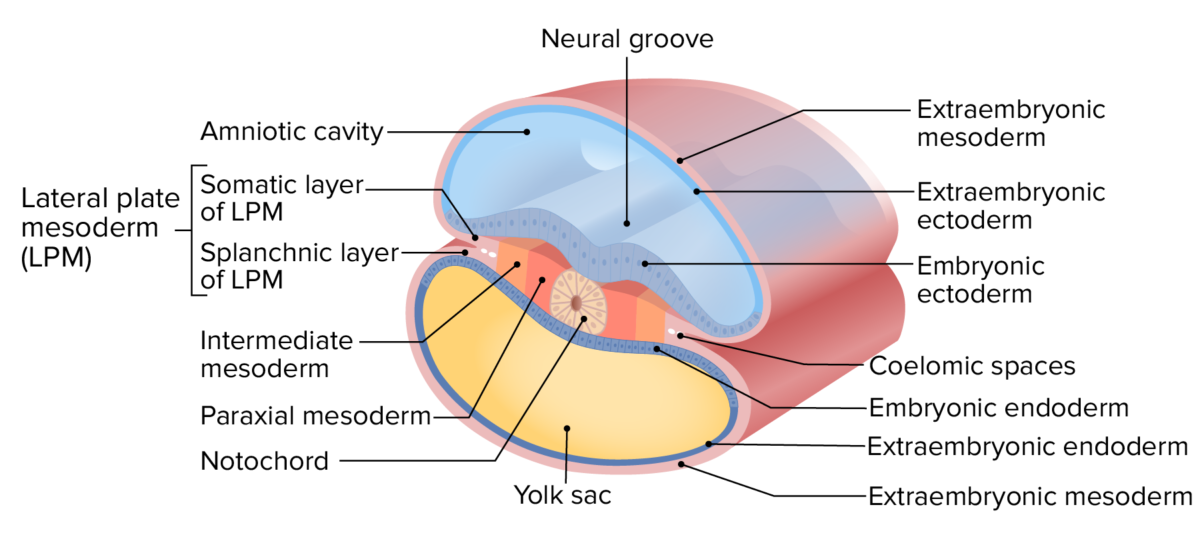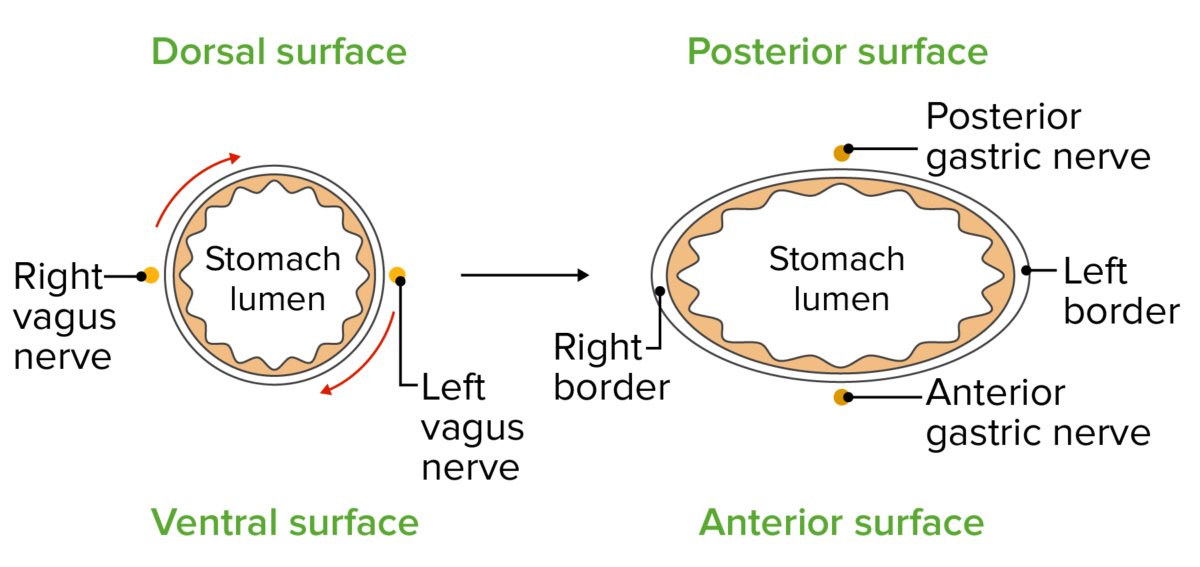The abdominal organs are derived primarily from endoderm Endoderm The inner of the three germ layers of an embryo. Gastrulation and Neurulation, which forms the primitive gut tube. The gut tube is divided into 3 regions: foregut, midgut, and hindgut. The foregut gives rise to the lining of the GI tract from the esophagus Esophagus The esophagus is a muscular tube-shaped organ of around 25 centimeters in length that connects the pharynx to the stomach. The organ extends from approximately the 6th cervical vertebra to the 11th thoracic vertebra and can be divided grossly into 3 parts: the cervical part, the thoracic part, and the abdominal part. Esophagus: Anatomy to the upper duodenum Duodenum The shortest and widest portion of the small intestine adjacent to the pylorus of the stomach. It is named for having the length equal to about the width of 12 fingers. Small Intestine: Anatomy, as well as the liver Liver The liver is the largest gland in the human body. The liver is found in the superior right quadrant of the abdomen and weighs approximately 1.5 kilograms. Its main functions are detoxification, metabolism, nutrient storage (e.g., iron and vitamins), synthesis of coagulation factors, formation of bile, filtration, and storage of blood. Liver: Anatomy, gallbladder Gallbladder The gallbladder is a pear-shaped sac, located directly beneath the liver, that sits on top of the superior part of the duodenum. The primary functions of the gallbladder include concentrating and storing up to 50 mL of bile. Gallbladder and Biliary Tract: Anatomy, and pancreas Pancreas The pancreas lies mostly posterior to the stomach and extends across the posterior abdominal wall from the duodenum on the right to the spleen on the left. This organ has both exocrine and endocrine tissue. Pancreas: Anatomy. The midgut gives rise to the GI tract lining between the midduodenum and midtransverse colon Colon The large intestines constitute the last portion of the digestive system. The large intestine consists of the cecum, appendix, colon (with ascending, transverse, descending, and sigmoid segments), rectum, and anal canal. The primary function of the colon is to remove water and compact the stool prior to expulsion from the body via the rectum and anal canal. Colon, Cecum, and Appendix: Anatomy. The hindgut gives rise to the GI tract lining from the midtransverse colon Colon The large intestines constitute the last portion of the digestive system. The large intestine consists of the cecum, appendix, colon (with ascending, transverse, descending, and sigmoid segments), rectum, and anal canal. The primary function of the colon is to remove water and compact the stool prior to expulsion from the body via the rectum and anal canal. Colon, Cecum, and Appendix: Anatomy through the upper anal canal. The mesoderm Mesoderm The middle germ layer of an embryo derived from three paired mesenchymal aggregates along the neural tube. Gastrulation and Neurulation gives rise to the muscles of the GI tract wall, connective tissue Connective tissue Connective tissues originate from embryonic mesenchyme and are present throughout the body except inside the brain and spinal cord. The main function of connective tissues is to provide structural support to organs. Connective tissues consist of cells and an extracellular matrix. Connective Tissue: Histology (including the mesenteries and omenta), and the vasculature. The ectoderm Ectoderm The outer of the three germ layers of an embryo. Gastrulation and Neurulation gives rise to the nerve tissue and the lining of the lower anal canal.
Last updated: Mar 29, 2023
The morula Morula An early embryo that is a compact mass of about 16 blastomeres. It resembles a cluster of mulberries with two types of cells, outer cells and inner cells. Morula is the stage before blastula in non-mammalian animals or a blastocyst in mammals. Fertilization and First Week (ball of cells) undergoes a process called blastulation, in which a cavity begins to form. The cells then begin differentiating into outer and inner cell masses.

Relationship of the bilaminar disc, yolk sac, and amniotic cavity in the early embryo
Image by Lecturio. License: CC BY-NC-SA 4.0The bilaminar disk undergoes a process called gastrulation Gastrulation Both gastrulation and neurulation are critical events that occur during the 3rd week of embryonic development. Gastrulation is the process by which the bilaminar disc differentiates into a trilaminar disc, made up of the 3 primary germ layers: the ectoderm, mesoderm, and endoderm. Gastrulation and Neurulation to form the trilaminar disc Trilaminar disc Gastrulation and Neurulation. There are 3 layers of the trilaminar disc Trilaminar disc Gastrulation and Neurulation:
Forces the yolk sac Yolk Sac The first of four extra-embryonic membranes to form during embryogenesis. In reptiles and birds, it arises from endoderm and mesoderm to incorporate the egg yolk into the digestive tract for nourishing the embryo. In placental mammals, its nutritional function is vestigial; however, it is the source of intestinal mucosa; blood cells; and germ cells. It is sometimes called the vitelline sac, which should not be confused with the vitelline membrane of the egg. Embryoblast and Trophoblast Development farther from the body.→ The elongating stalk connecting the yolk sac Yolk Sac The first of four extra-embryonic membranes to form during embryogenesis. In reptiles and birds, it arises from endoderm and mesoderm to incorporate the egg yolk into the digestive tract for nourishing the embryo. In placental mammals, its nutritional function is vestigial; however, it is the source of intestinal mucosa; blood cells; and germ cells. It is sometimes called the vitelline sac, which should not be confused with the vitelline membrane of the egg. Embryoblast and Trophoblast Development to the gut tube is the vitelline duct Vitelline duct The narrow tube connecting the yolk sac with the midgut of the embryo; persistence of all or part of it in post-fetal life produces abnormalities, of which the commonest is meckel diverticulum. Meckel’s Diverticulum.

Layers of the trilaminar disc.
Image by Lecturio.
Cross-sectional view of the early embryo after it has undergone lateral folding
Image by Lecturio.
The early embryo with the amniotic sac above the embryo and the yolk sac below the embryo
Image by Lecturio.
The early embryo with the amniotic sac above the embryo and the yolk sac below the embryo
Image by Lecturio.The primitive gut tube is formed from endoderm Endoderm The inner of the three germ layers of an embryo. Gastrulation and Neurulation at the completion of lateral folding. The gut tube can initially be divided into 3 areas: foregut, midgut, and hindgut.

Development of the dorsal mesentery with the primitive gut tube
Image by Lecturio.Key structures derived from endoderm Endoderm The inner of the three germ layers of an embryo. Gastrulation and Neurulation related to development of the abdominal organs:
Key structures derived from mesoderm Mesoderm The middle germ layer of an embryo derived from three paired mesenchymal aggregates along the neural tube. Gastrulation and Neurulation related to development of the abdominal organs:
Splanchnic layer of the LPM:
Somatic layer of the LPM: parietal Parietal One of a pair of irregularly shaped quadrilateral bones situated between the frontal bone and occipital bone, which together form the sides of the cranium. Skull: Anatomy peritoneum Peritoneum The peritoneum is a serous membrane lining the abdominopelvic cavity. This lining is formed by connective tissue and originates from the mesoderm. The membrane lines both the abdominal walls (as parietal peritoneum) and all of the visceral organs (as visceral peritoneum). Peritoneum: Anatomy
Key structures derived from ectoderm Ectoderm The outer of the three germ layers of an embryo. Gastrulation and Neurulation related to development of the abdominal organs:
Separation from the respiratory system:
Growth and descent:

Embryonic development of the bronchial tree
Image by Lecturio. License: CC BY-NC-SA 4.0
The stomach rotates clockwise 1st along its longitudinal axis and then along its anteroposterior axis:
The original dorsal side of the stomach grows faster than the original ventral side, creating the greater and lesser curvatures of the stomach.
Image by Lecturio.
A closer look at the rotation of the stomach clearly explains why the left vagus nerve contributes more heavily to the anterior vagal trunk and the right vagus nerve to the posterior vagal trunk.
Image by Lecturio.The greater and lesser omenta are formed from the dorsal and ventral mesogastrium (of mesodermal origin). As they rotate with the stomach Stomach The stomach is a muscular sac in the upper left portion of the abdomen that plays a critical role in digestion. The stomach develops from the foregut and connects the esophagus with the duodenum. Structurally, the stomach is C-shaped and forms a greater and lesser curvature and is divided grossly into regions: the cardia, fundus, body, and pylorus. Stomach: Anatomy, they create the greater and lesser sacs.
Dorsal mesogastrium:
Ventral mesogastrium:

Rotation of the stomach and gastric mesenteries
Image by Lecturio.
Double-bubble sign on radiography (invertography) indicating duodenal obstruction:
The smaller bubble on the individual’s right is air in the duodenum, and the larger bubble on the left is air in the stomach.

Anatomy of the biliary and pancreatic ducts
Image by BioDigital, edited by LecturioThe midgut develops into the lining of the GI tract from the distal duodenum Duodenum The shortest and widest portion of the small intestine adjacent to the pylorus of the stomach. It is named for having the length equal to about the width of 12 fingers. Small Intestine: Anatomy (below the ampulla of Vater) to the midtransverse colon Colon The large intestines constitute the last portion of the digestive system. The large intestine consists of the cecum, appendix, colon (with ascending, transverse, descending, and sigmoid segments), rectum, and anal canal. The primary function of the colon is to remove water and compact the stool prior to expulsion from the body via the rectum and anal canal. Colon, Cecum, and Appendix: Anatomy. The hindgut develops into the GI tract from the distal ⅓ of the transverse colon Transverse colon The segment of large intestine between ascending colon and descending colon. It passes from the right colic flexure across the abdomen, then turns sharply at the left colonic flexure into the descending colon. Colon, Cecum, and Appendix: Anatomy through the anus.

Diagram showing the normal process of intestinal rotation and herniation during embryologic development
A: The midgut (multicolored loop) before herniation.
B1–B3: As it grows rapidly, the midgut herniates through the umbilical ring and starts rotation.
C: The midgut returns to the abdominal cavity.
The hindgut develops simultaneously and in close association with the urogenital system.

Between weeks 4 and 7, the urorectal septum begins growing into the cloaca, starting at its proximal end and growing distally until it reaches the outside of the embryo, fully separating the cloaca into the urogenital sinus and the anal canal.
Image by Lecturio.